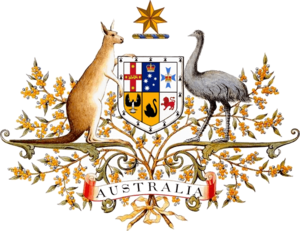Native Title Act 1993 facts for kids
Quick facts for kids Native Title Act 1993 |
|
|---|---|
 |
|
| Parliament of Australia | |
| An Act about native title in relation to land or waters, and for related purposes. | |
| Citation | or |
| Territorial extent | States and territories of Australia |
| Date of Royal Assent | 24 December 1993 |
| Status: Substantially amended | |
The Native Title Act 1993 is an important law made by the Australian Parliament. Its main goal is to officially recognise and protect native title rights. It also helps these rights exist alongside Australia's regular land management system. This law was created after a big decision by the High Court in 1992, known as Mabo v Queensland (No 2). The Act started working on 1 January 1994.
Contents
What is the Native Title Act?
This law was made to put the Mabo decision into action. It set up ways to make it easier to recognise native title in Australia. The Act also created the National Native Title Tribunal. This Tribunal helps to register, hear, and decide on native title claims.
The Native Title Act protects native title where:
- People have rights and interests under their traditional laws and customs.
- These laws and customs are still followed by the Indigenous Australians involved.
- Through these laws and customs, Indigenous Australians have a connection to the land or water.
- The Australian legal system officially recognises these native title rights.
The Act also sets up processes to find out where native title exists. It explains how new activities that might affect native title can happen. It also makes sure that Indigenous Australians get paid if their native title is harmed or taken away.
Indigenous Australians who have native title rights, or who have made a claim, have a right to be asked for their opinion. Sometimes, they can also help make decisions about activities planned for the land. This has helped Indigenous communities get benefits, like job chances and protection for their cultural heritage.
The Act also helps create and support groups that provide services to native title claimants. The Australian Government gives money to help solve native title issues. This funding goes to groups that represent native title holders, the National Native Title Tribunal, and the Federal Court of Australia.
The Aboriginal and Torres Strait Islander Social Justice Commissioner used to write a yearly report. This report was about how the Act affected the human rights of Aboriginal and Torres Strait Islander peoples. The Commissioner also helped make native title processes better. They also worked to help Indigenous and non-Indigenous people share land peacefully.
How the Act Has Changed
Over time, the Native Title Act has been changed several times. These changes often happen after important court decisions or to make the system work better.
The 1998 Changes: The "10-Point Plan"
One big change happened in 1998 with the Native Title Amendment Act 1998. This was also called the "10-Point Plan". It came after another important High Court decision called Wik. The Wik decision said that native title could exist at the same time as pastoral leases (land used for grazing animals). This was a surprise to many people.
Some people worried that this decision would cause problems for land ownership. However, the court said that the rights of farmers would be more important than native title rights if there was a conflict. The 1998 changes made native title harder to claim. They also gave states more power to manage claims. These changes also introduced Indigenous land use agreements. These agreements are a way for Indigenous and non-Indigenous people to agree on how land will be used.
The "10-Point Plan" included:
- The National Native Title Tribunal has the final say on native title claims.
- State governments can end native title on Crown lands for important national reasons.
- Land used for public things, like parks, cannot have native title claims.
- Mining and pastoral leases can exist alongside native title.
- The National Native Title Tribunal can allow access to traditional lands instead of giving full native title.
- All people making claims must pass a special registration test.
- You cannot claim native title in or near city areas.
- The government can manage land, water, and air issues anywhere.
- There are very strict time limits for all claims.
- Indigenous land use agreements are created to help people share land.
Many groups, like ANTaR, spoke out against these changes. They felt the changes made native title rights weaker. The United Nations Committee on the Elimination of Racial Discrimination also worried that the changes might not follow international human rights rules.
Later Changes
More changes were made in 2007 by the Howard Government. These changes aimed to make the native title process faster. The Rudd Government also made changes in 2009. These allowed the Federal Court to decide who should help solve a claim.
The Act is still looked at and changed. In 2015, the Australian Law Reform Commission suggested 30 ways to improve it. They wanted to make the process of deciding native title claims more effective. Since 2015, the Act has been changed six more times.
What the Act Has Achieved
The Native Title Act has been very important for Indigenous Australians. In 1995, the High Court supported the Native Title Act in a case called Western Australia v Commonwealth. This showed the Act's strength and importance.
See also

